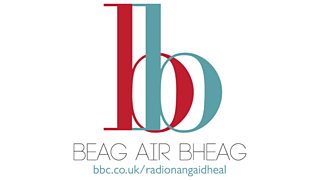Blasad Beag - Episode 10: What time is it?
Fàilte aon uair eile gu Blasad Beag. Welcome back to Blasad Beag, the section of the programme especially for those of you who are either absolute beginners, or have only recently started learning the language.

Today, we’re going to talk about time. We’ll teach you how to ask for the time in Gaelic, and also how to tell someone what the time is.
Nach tòisich sinn ma-thà? Let’s get started. If you want to ask someone what the time is, you would say Dè an uair a tha e? What is the time? Dè an uair a tha e? Dè an uair a tha e?
Nise, ciamar a fhreagradh sibh a’ cheist ud? How would you answer that question? If you want to say what time it is, you would say Tha e... uairean, with the correct number between the words e and uairean. Èistibh ri Calum agus Eilidh. Listen to the following conversation between Calum and Eilidh, and try to figure out what time Eilidh says it is.
Calum: Dè an uair a tha e?
Eilidh: Tha e ochd uairean.
An d’ fhuair sibh ceart e? Did you get it right? Eilidh said it is eight o’ clock. Tha e ochd uairean. It is eight o’ clock.
Following that pattern, if it was four o’ clock. Tha e ceithir uairean. Tha e ceithir uairean. And if it was ten o’ clock? Tha e deich uairean. Tha e deich uairean.
However, if it was eleven o’ clock, you put the word uair between the words aon and deug. Tha e aon uair deug. Aon uair deug. Literally “one hour teen”. Eleven o’ clock. Tha e aon uair deug.
There are also a couple of exceptions where you would use the singular form of the noun uair. For one o’ clock you would say, Tha e uair followed by the word feasgar, if it’s the afternoon, tha e uair feasgar. Or the words sa mhadainn if it’s early in the morning. Tha e uair sa mhadainn. Feasgar and sa mhadainn can also be used following any time.
Tha e uair feasgar. It’s one in the afternoon. Tha e uair feasgar.
Tha e uair sa mhadainn. It’s one in the morning. Tha e uair sa mhadainn.
You would also follow the same structure for two o’ clock. Tha e dà uair feasgar means it’s two o’ clock in the afternoon. Tha e dà uair feasgar.
Two other words you might find useful while telling the time are meadhan-latha and meadhan-oidhche.
Meadhan-latha. Midday. Meadhan-latha.
Meadhan-oidhche. Midnight. Meadhan-oidhche.
Tha e meadhan-latha. It’s midday. Tha e meadhan-latha.
Tha e meadhan-oidhche. It’s midnight. Tha e meadhan-oidhche.
Finally, if you want to say the time in quarter hour intervals, you would use the following phrases:
Cairteal an dèidh. Quarter past. Cairteal an dèidh. Tha e cairteal an dèidh trì. It is quarter past three. Tha e cairteal an dèidh trì.
Leth-uair an dèidh. Half past. Leth-uair an dèidh. Tha e leth-uair an dèidh meadhan-oidhche. It is half past midnight. Tha e leth-uair an dèidh meadhan-oidhche.
Cairteal gu. Quarter to. Tha e cairteal gu aon uair deug sa mhadainn. It is quarter to eleven in the morning. Tha e cairteal gu aon uair deug sa mhadainn.
Èistibh ri Calum agus Eilidh aon uair eile. Listen once more to Calum and Eilidh, and see if you can follow their conversation.
Eilidh: Dè an uair a tha e?
Calum: Tha e cairteal gu còig.
Eilidh: Bha dùil a’m gun robh e leth-uair an dèidh ceithir.
Eilidh asked Calum what the time is. Dè an uair a tha e?
Calum replied that it was quarter to five. Tha e cairteal gu còig.
Eilidh said she thought that it was half past four. Bha dùil a’m gu robh e leth-uair an dèidh ceithir. Bha dùil a’m gu robh e leth-uair an dèidh ceithir.
Agus sin agaibh e! That’s a basic introduction to telling time in Gaelic. And remember, there are lots of great learning resources available too at www.learngaelic.scot, including a beginner’s App that you can download! Mar sin leibh!

